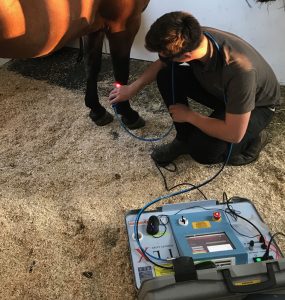Equine Therapy for Kid: Emotional and Behavioral Assistance Described
Equine Therapy for Kid: Emotional and Behavioral Assistance Described
Blog Article
Laser Treatment in Equine Treatment: A Modern Technique to Improving Steed Wellness
Laser treatment has emerged as a critical technique in equine therapy, making use of concentrated light energy to cultivate mobile repair and speed up recovery from a variety of disorders. By promoting mitochondrial activity and enhancing ATP manufacturing, laser therapy not just enhances circulation but additionally offers substantial discomfort relief.
Understanding Laser Treatment
Laser therapy, a non-invasive treatment technique, has actually acquired substantial traction in equine medicine due to its effectiveness in advertising recovery and pain relief. Boosted ATP degrees speed up cells fixing processes and minimize swelling, making laser therapy especially reliable for dealing with musculoskeletal injuries, wounds, and other inflammatory problems in steeds - Equine Therapy.
There are several types of lasers used in equine therapy, each with particular wavelengths and power outputs tailored to different restorative requirements. Low-level laser treatment (LLLT), also recognized as chilly laser treatment, uses lower power levels to stimulate cell function without triggering thermal damages. High-intensity laser therapy (HILT), on the other hand, uses greater power levels to achieve much deeper tissue penetration and even more considerable therapeutic impacts.
Veterinarians utilize different laser tools and techniques relying on the condition being dealt with and the preferred deepness of cells penetration. Proper training and know-how are crucial for guaranteeing the risk-free and efficient application of laser therapy, thus optimizing its healing possibility while decreasing risks.
Benefits for Horse Health


With a solid understanding of how laser therapy functions, it is essential to explore its various benefits for equine health. By promoting mobile feature, laser therapy promotes faster injury healing and aids in the regrowth of broken tissues.
Additionally, laser treatment has actually been shown to improve flow, consequently boosting blood circulation to affected locations. Enhanced flow makes sure that important nutrients and oxygen are provided more efficiently, helping with the healing procedure. Furthermore, laser therapy's anti-inflammatory effects help in reducing swelling and pain, which is critical for the overall wellness of the equine.
Discomfort administration is one more substantial advantage. By releasing endorphins and blocking pain signals, laser therapy offers efficient, non-invasive remedy for both acute and persistent discomfort. This can add to enhanced movement and lifestyle for the pet.
Finally, laser therapy is a non-invasive treatment choice, decreasing the risk of difficulties connected with even more intrusive treatments. Its convenience and efficiency make it an invaluable device in contemporary horse vet medicine.
Common Problems Treated
Equine specialists often come across a selection of conditions that can be efficiently handled via laser therapy. Amongst one of the most common are bone and joint concerns, including tendon and ligament injuries. Laser treatment speeds up the healing process by enhancing mobile fixing and lowering swelling, which is crucial for injuries such as tendonitis and suspensory tendon desmitis.
One more prevalent condition treated with laser therapy is joint inflammation. Additionally, laser therapy is utilized in the monitoring of injuries.
Horse breathing problems, such as recurring respiratory visit this web-site tract obstruction (RAO), additionally react positively to laser therapy. The anti-inflammatory properties of the therapy aid in decreasing air passage swelling, thus improving respiratory system function. Laser therapy is useful in dealing with hoof problems, consisting of laminitis and abscesses. By improving circulation and lowering discomfort, it supports quicker recuperation.
Procedure and Safety
Implementing laser treatment in equine therapy includes a careful treatment official site to ensure both effectiveness and safety and security. The procedure starts with a comprehensive veterinary analysis to identify the suitability of laser treatment for the equine's certain condition. As soon as regarded ideal, the therapy area is prepared by cleansing and, if necessary, clipping the hair to boost laser penetration.
The practitioner must choose the appropriate kind of laser, usually a low-level laser (LLLT) or a high-power laser (HPL), depending on the problem being treated. The laser device is then adjusted to the suitable wavelength, power, and duration settings. During the application, the professional moves the laser over the targeted location in a systematic manner, making sure constant and also direct exposure.
Safety and security methods are purely stuck to, including using safety eyewear for both the specialist and the steed. In addition, it visit is essential to check the equine for any type of signs of pain or damaging reactions throughout the treatment. Post-treatment, the steed is typically provided a duration of rest to enable the therapeutic results to materialize.
Future of Equine Laser Treatment
As innovations in vet medicine continue to unravel, the future of equine laser treatment holds substantial assurance. Arising modern technologies and deeper scientific understandings are set to improve and broaden the applications of laser treatment for equines.
In addition, ongoing research study right into the molecular and cellular systems of laser treatment will likely generate enhanced protocols tailored to specific problems, improving effectiveness and lowering therapy times. Customized therapy strategies based on hereditary and biochemical markers can come to be a fact, guaranteeing that each horse obtains one of the most appropriate and reliable care.

Conclusion
Laser therapy in equine treatment represents a considerable advancement in vet treatment, supplying a non-invasive solution to boost equine wellness. The future of equine laser treatment promises continued development and improved outcomes for equine health monitoring.
Report this page